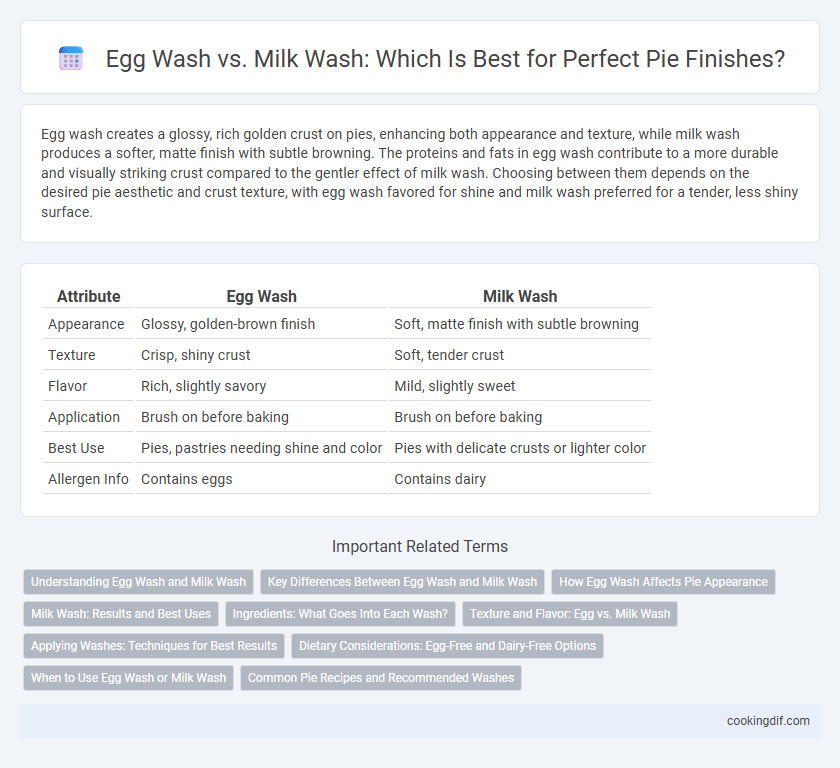Egg wash creates a glossy, rich golden crust on pies, enhancing both appearance and texture, while milk wash produces a softer, matte finish with subtle browning. The proteins and fats in egg wash contribute to a more durable and visually striking crust compared to the gentler effect of milk wash. Choosing between them depends on the desired pie aesthetic and crust texture, with egg wash favored for shine and milk wash preferred for a tender, less shiny surface.
Table of Comparison
| Attribute | Egg Wash | Milk Wash |
|---|---|---|
| Appearance | Glossy, golden-brown finish | Soft, matte finish with subtle browning |
| Texture | Crisp, shiny crust | Soft, tender crust |
| Flavor | Rich, slightly savory | Mild, slightly sweet |
| Application | Brush on before baking | Brush on before baking |
| Best Use | Pies, pastries needing shine and color | Pies with delicate crusts or lighter color |
| Allergen Info | Contains eggs | Contains dairy |
Understanding Egg Wash and Milk Wash
Egg wash, composed primarily of beaten eggs sometimes mixed with water or milk, provides a glossy, golden-brown finish to pie crusts and enhances browning due to its protein content. Milk wash, typically whole or skim milk brushed onto pastries, results in a softer, matte finish with a slight sweetness but less shine compared to egg wash. Understanding the differences in protein and fat content between egg wash and milk wash helps bakers select the ideal glaze to achieve the desired crust texture and appearance on pies.
Key Differences Between Egg Wash and Milk Wash
Egg wash, composed of beaten eggs or eggs mixed with water or milk, creates a glossy, golden-brown finish and enhances browning and texture on pie crusts. Milk wash provides a softer sheen with a lighter color and less pronounced browning, offering a tender texture ideal for delicate pastries. The key differences lie in the richness, color intensity, and desired crust crispness, with egg wash delivering a vibrant, crunchy surface and milk wash producing a subtle, matte finish.
How Egg Wash Affects Pie Appearance
Egg wash enhances pie appearance by providing a rich, glossy, and golden-brown finish that highlights intricate crust designs and lattice patterns. The proteins and fats in egg wash promote Maillard browning, resulting in an appetizing, crisp surface texture. Compared to milk wash, egg wash creates a more vibrant and visually appealing crust that elevates the overall presentation of baked pies.
Milk Wash: Results and Best Uses
Milk wash creates a golden, slightly glossy finish on pie crusts, offering a softer and more matte appearance compared to egg wash. It is ideal for sweet pies, as it enhances browning without adding a sticky texture or altering flavor significantly. The milk's natural sugars promote even browning, making it a preferred choice for fruit pies and delicate pastries.
Ingredients: What Goes Into Each Wash?
Egg wash typically consists of beaten eggs, sometimes mixed with water or milk to enhance shine and adhesion on pie crusts. Milk wash is made from milk or cream alone, providing a softer, matte finish without the glossiness that egg wash imparts. Both washes contribute to browning, but egg wash contains proteins and fats that create a richer golden color and firmer crust texture.
Texture and Flavor: Egg vs. Milk Wash
Egg wash creates a glossy, golden-brown crust with a slightly richer flavor that enhances the pie's overall taste. Milk wash produces a softer, matte finish with a tender texture and a subtle, creamy note. Choosing egg or milk wash affects both the pie's appearance and mouthfeel, with egg wash offering a more pronounced crunch and milk wash delivering a delicate softness.
Applying Washes: Techniques for Best Results
Applying egg wash involves brushing a beaten egg, sometimes mixed with water or milk, evenly over the pie crust to achieve a glossy, golden-brown finish that enhances visual appeal and texture. Milk wash, consisting of whole milk or cream applied with a pastry brush, creates a softer, matte surface with subtle browning ideal for delicate pastries or pies. For best results, use a light hand to avoid pooling, apply washes just before baking, and consider multiple thin layers to control glossiness and crust crispness.
Dietary Considerations: Egg-Free and Dairy-Free Options
For dietary considerations, egg wash and milk wash differ significantly in allergen content, making egg wash unsuitable for those with egg allergies, while milk wash must be avoided by individuals with lactose intolerance or dairy allergies. Vegan and allergen-free alternatives like plant-based milk (e.g., almond or oat milk) or aquafaba can provide similar glossy finishes without animal-derived ingredients. Choosing the appropriate wash depends on accommodating dietary restrictions such as egg-free, dairy-free, or vegan requirements to ensure inclusive and safe pie preparation.
When to Use Egg Wash or Milk Wash
Egg wash is ideal for pies that require a deep golden, glossy finish and enhanced browning, such as fruit pies or savory pies with pastry tops. Milk wash provides a softer, matte finish and is best used when a more subtle crust color and a tender texture are desired, like in cream pies or delicate pastries. Choosing between egg wash and milk wash depends on the desired crust appearance and texture, with egg wash offering shine and crispness while milk wash promotes a gentler browning effect.
Common Pie Recipes and Recommended Washes
In common pie recipes, egg wash delivers a rich, glossy finish with a golden-brown color that enhances fruit and savory pies alike, thanks to its protein content that promotes browning. Milk wash provides a softer sheen and lighter crust color, favored for delicate pastries or creamy fillings where subtlety is preferred. For optimal pie finishing, egg wash is recommended for flaky or puff pastry crusts, while milk wash suits tender, shortcrust varieties to achieve the desired texture and appearance.
Egg wash vs Milk wash for finishing Infographic

 cookingdif.com
cookingdif.com